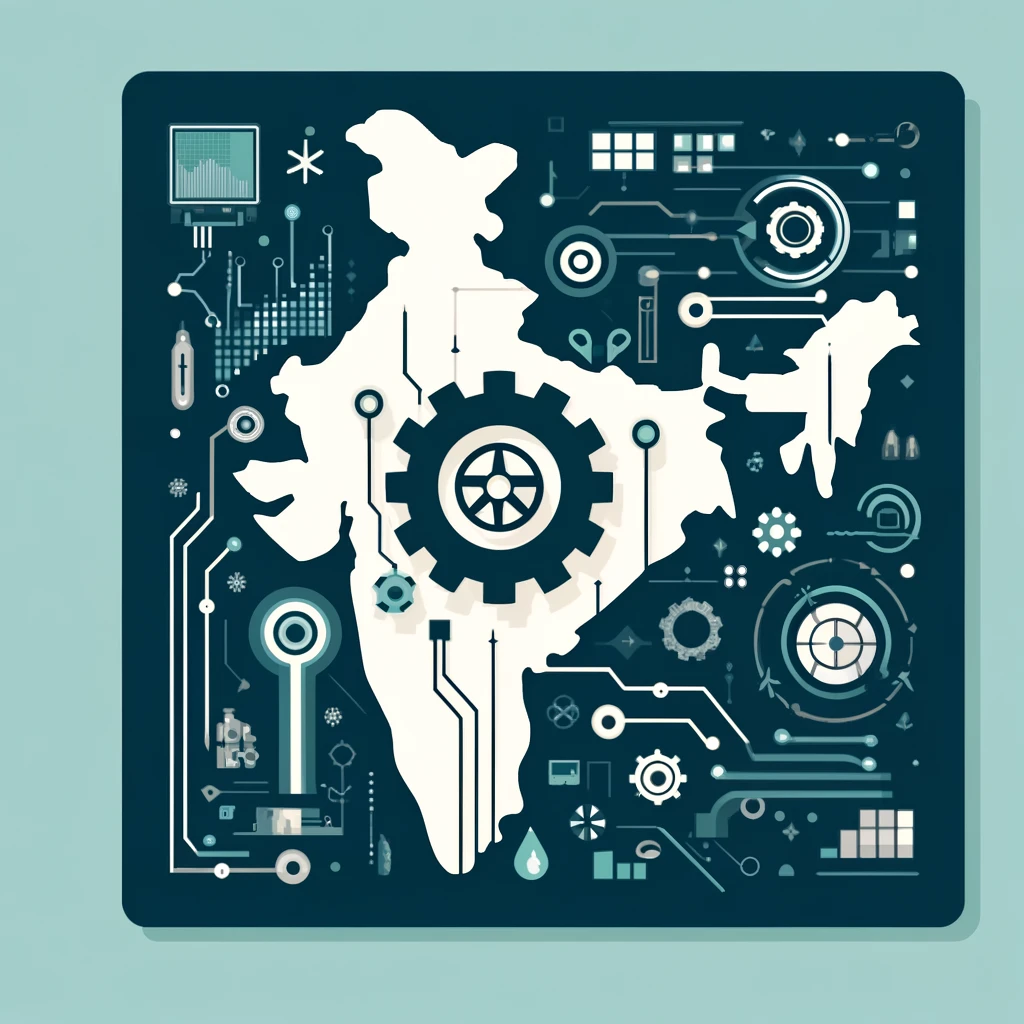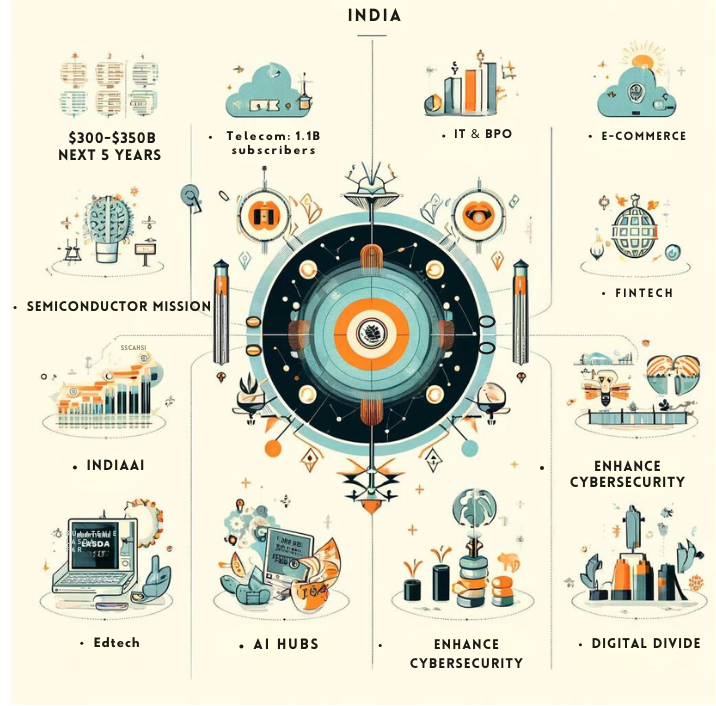
Introduction
In an era where technology stands as the cornerstone of progress and power, India is poised at a vital juncture in its quest for technological supremacy. The global landscape is swiftly evolving, with nations vying to dominate the realm of technology, recognizing its critical role in shaping economic might and national security. This editorial delves into India’s technology trajectory, exploring its current achievements, potential growth avenues, and the hurdles it must overcome. It underscores the urgent need for India to refine its technology strategy, ensuring global competitiveness while addressing the digital divide and fostering innovation. By examining the successes and challenges of India’s tech sector, the article outlines a roadmap for India to not only participate but excel in the global technological race.
Origin of the Article:
This editorial on technology trajectory is inspired by “Beyond the manifestos, technology challenges for India’s next government,” published in The Indian Express on May 1, 2024. It scrutinizes the global competition in technology and emphasizes the necessity for India to enhance its technological strategies to secure a prominent position on the global stage.
Relevance for UPSC Aspirants
This editorial encapsulates the evolving landscape of India’s technological sector and its implications for the country’s global competitiveness, resonating deeply with the UPSC syllabus, particularly for General Studies Paper III. For aspirants, understanding the dynamics of India’s technology trajectory and the government’s initiatives like India’s Semiconductor Mission, and IndiaAI Mission, alongside challenges such as the digital divide and cybersecurity threats, is crucial. This knowledge not only aids in grasping current affairs but also enriches one’s answers in Mains with practical examples and critical analysis of India’s position in the global technological race. Additionally, the article’s insights into sectors driving tech growth and strategic measures for sustainable development provide a comprehensive understanding necessary for both Prelims and Mains.
- Deep Tech
- India’s Semiconductor Mission
- Digital Divide
- Cybersecurity Threats
- Technological Skilling
- Global Technological Competitiveness
The Imperative of India’s Technological Evolution for UPSC Aspirants
Why in News: The editorial highlights the critical juncture at which India stands in the global technological race, emphasizing the nation’s need to revamp its technology strategy to ensure competitiveness on the world stage. For UPSC aspirants, understanding the dynamics of India’s tech sector, including government initiatives and challenges, is vital. It directly correlates with UPSC’s focus on technology’s impact on economic growth, societal transformation, and India’s position in global affairs.
This topic’s relevance has been underscored in previous years’ questions, reflecting the exam’s evolving nature towards current global and national trends, including technological advancements and their multifaceted implications. Engaging with this topic prepares aspirants to tackle issues of the digital divide, cybersecurity, and innovation, essential for governance, international relations, and economic policies, making it indispensable for comprehensive UPSC exam preparation.
India’s Technology Trajectory

Current Scenario
The Indian technology industry is on a remarkable growth path, anticipated to achieve a revenue landmark of USD 300–USD 350 billion within the next five years. This growth is reflected in the telecom industry, which stands as the world’s second-largest, and India’s position as the second-largest mobile handset manufacturer globally. Notably, the startup ecosystem in India has burgeoned into the world’s third-largest, boasting over 1.25 lakh startups, including 110 unicorns, showcasing the vibrant entrepreneurial spirit driving India’s tech ascendancy.
Key Sub-Sectors Driving India’s Tech Growth
IT and BPO Services
The IT and BPO services sector, accounting for over 60% of India’s service exports, plays a pivotal role in the country’s tech-driven growth narrative. This sector’s contribution underscores the critical importance of service exports in bolstering India’s economic resilience and global competitiveness.
E-Commerce
Projected to reach a staggering USD 1 trillion by 2030, India’s e-commerce market is on an exponential rise. Factors such as a vast consumer base, robust digital infrastructure, and a well-oiled supply chain ecosystem are the driving forces behind this phenomenal growth, highlighting the sector’s potential to shape India’s economic landscape.
FinTech and Digital Finance
India’s fintech sector is witnessing rapid growth, with digital payments through UPI playing a significant role. Expected to reach USD 150 billion by 2025, this sector’s expansion is a testament to India’s potential to lead the global digital finance arena.
Edtech
The pandemic has notably accelerated the growth of India’s ed-tech sector, making it the second-largest market for e-learning globally. With a market size of USD 6 billion, projected to grow to USD 10 billion by 2025, edtech stands as a key pillar in India’s tech growth story.
Cleantech and Renewable Energy
India’s renewable energy sector is making significant strides, ranking 4th globally in renewable power capacity additions. The achievement of the non-fossil fuel target ahead of schedule is a clear indication of India’s commitment to sustainable growth through innovation in cleantech.
Space Sector
Contributing 2%–3% to the global space economy, India aims to increase its share to 10% by 2030. Recent successful missions underscore India’s ambitions and capabilities to become a leading player in the global space economy.
Government Initiatives Driving Technological Growth
India’s Semiconductor Mission
Launched in 2021, the mission aims to establish a sustainable semiconductor and display ecosystem, marking a significant step towards technological self-reliance.
IndiaAI Mission
With a budget exceeding Rs 10,300 crore, the mission focuses on bolstering India’s AI ecosystem through various initiatives, aiming to democratize AI benefits and foster ethical deployment.
DigiLocker
As part of the Digital India program, DigiLocker exemplifies the government’s push towards a digitally empowered society, providing secure cloud-based storage for documents and certificates.
Unified Payment Interface (UPI)
Developed by NPCI, UPI has revolutionized digital payments in India, showcasing the government’s commitment to fostering financial inclusivity and digital empowerment.
Mission on Advanced and High-Impact Research (MAHIR)
Focusing on the power sector, MAHIR aims to propel India forward in clean energy solutions and smart grid technologies, highlighting the government’s focus on sustainable and advanced research.
PLI Schemes
Targeting various sectors, PLI schemes aim to enhance manufacturing capabilities, underscoring the government’s strategy to boost domestic production and reduce dependency on imports.
National Supercomputing Mission
Jointly steered by DST and MeitY, this mission aims to significantly enhance India’s computing power, reflecting the government’s vision for a technologically advanced nation.
Major Technology-Related Challenges in India
Digital Divide
The urban-rural divide in internet access remains a significant challenge, with a substantial portion of the population lacking ICT access, underscoring the need for more inclusive digital connectivity strategies.
Lack of Relevant Skill
The demand for specialized skills in emerging tech areas highlights the skill gap in India’s workforce, pointing to the urgent need for educational reforms to equip individuals with relevant technological expertise.
Lack of Adequate Focus on R&D
India’s relatively low investment in R&D, compared to developed nations, hampers innovation and limits the country’s capability to produce cutting-edge technologies, necessitating increased R&D investment.
Cybersecurity Threats
The rise in cybersecurity incidents underscores the critical need for robust security measures to protect against online fraud and cyberattacks, emphasizing the importance of enhancing India’s cybersecurity infrastructure.
Lack of Comprehensive Regulation on AI
The absence of comprehensive AI regulation poses risks and uncertainties, indicating the need for clear legal frameworks to govern AI deployment and ensure ethical practices.
Future Implications
Quantum Leap Alliances
Forming strategic alliances for advancements in quantum computing could position India at the forefront of global tech innovation, fostering collaborative research and development efforts.
AI-powered Rural Entrepreneurship Hubs
Establishing AI-powered kiosks in rural areas could empower local entrepreneurs, connecting them with essential resources and markets, thus driving inclusive economic growth.
Moonshot Innovation Labs
Creating DARPA-inspired labs for high-risk research could catalyze breakthroughs in critical tech domains, propelling India into a leadership position in global innovation.
TechnoSkilling for Future
Building alliances between industry, academia, and government for skill development in emerging technologies is crucial for creating a future-ready workforce and ensuring India’s competitiveness in the global tech landscape.
Enhancing Cybersecurity
Implementing a comprehensive cyber resilience framework is imperative to safeguard against evolving cyber threats and ensure secure and trustworthy tech environments for India’s digital journey.
Way Forward
During technological evolution, India’s path forward demands a multifaceted strategy aimed at harnessing and nurturing technological innovation for societal and economic upliftment. As future leaders, UPSC aspirants should ponder on creating an ecosystem that not only thrives on technological advancements but also ensures equitable access across the diverse strata of Indian society. This includes bolstering digital infrastructure in remote areas to bridge the urban-rural divide, emphasizing on the importance of R&D by allocating more resources and encouraging public-private partnerships, and focusing on cybersecurity to safeguard the nation’s digital frontiers. Moreover, integrating technology in education through innovative platforms can revolutionize the learning experience, preparing a future workforce that is adept and agile in facing the challenges of tomorrow. The goal should be to create a sustainable, inclusive, and technologically advanced society where every citizen has the opportunity to grow and contribute to the nation’s development. Engaging with these ideas can provide a robust foundation for aspirants to not only excel in their exams but also to envision and contribute towards a progressive India.
Conclusion
As India navigates the complexities of the global technological arena, the journey ahead demands a strategic overhaul of its tech landscape. The insights from the article underscore the imperative for India to bolster its tech sector, not merely as a participant but as a frontrunner in the global tech race. For UPSC aspirants, understanding the nuances of India’s tech trajectory is crucial, as it intertwines with every aspect of governance, economy, and societal progress.
The call to action is clear: to envision a future where technology is an equitable force, driving India towards sustainable development and inclusive growth. Let this understanding shape your perspective as future policymakers, where technology becomes a pivotal tool in crafting policies that are resilient, innovative, and forward-thinking.

